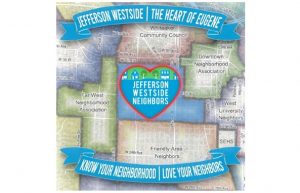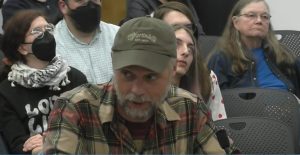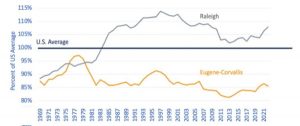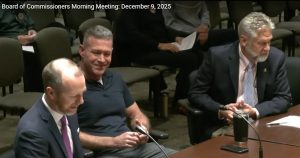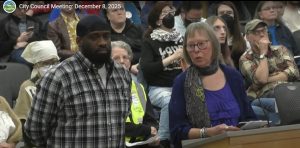City to ask state for help on hospital closure
10 min read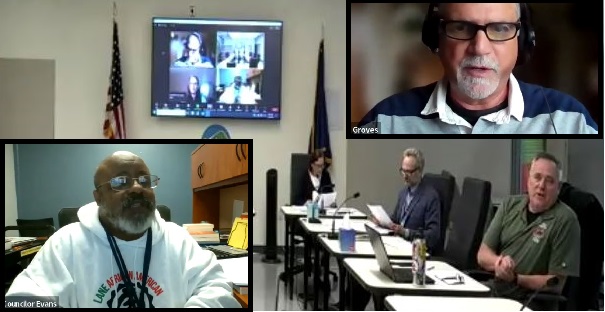
A new top legislative priority for the city. Reporting on the Intergovernmental Relations Committee Nov. 13, Councilor Greg Evans.
Councilor Greg Evans: The IGR committee added a new top priority for the 2024 session: to secure one-time funding to provide community response to PeaceHealth University District closure. Both the 2024 Oregon priorities and the 2024 state and federal priority documents will come to the full city council for discussion, action, at a work session currently scheduled for Nov. 27.
[00:00:38] John Q: At the IGR Committee Nov. 8:
[00:00:43] Deputy Fire Chief Chris Heppel: Mayor, Councilors: Thanks for this opportunity to chat with you a little bit about the challenges that we’re experiencing with the PeaceHealth system.
[00:00:49] I’m sure you’ve heard about the impending closure of University District emergency room. There’s also some ancillary components that are associated with that as well. Obviously, the challenge that we’re going to experience with that is we no longer have an emergency room in Eugene, which is one of our three primary destinations for our ambulance system.
[00:01:08] On average, we take about 13 patients by ambulance per day to University District, and we transport approximately eight per day out of there. So, cumulatively, we’re looking at over 20 patients a day coming in and out of that particular facility.
[00:01:24] Many of the folks who go to that facility don’t necessarily come by ambulance. In fact, most of them either drive themselves or many just walk to that particular facility. The challenge that we feel we’re going to run into is the hole that this is going to create, obviously, within our downtown system.
[00:01:39] We also want to acknowledge that there’s going to be an impact on the University of Oregon as many of their students during off-hours of their clinic is not open will just walk themselves over to University District, and aren’t going to have that option going forward.
[00:01:54] I think the other piece is to acknowledge the challenge around folks and that the ER many times is their primary care because they don’t have access via other means, or they choose not to use access via other means, and they choose to go to the emergency room.
[00:02:09] We’ve been working for the last few years to infuse some innovative concepts into our system to help the system as a whole with regards to alternative transport. And after some conversations with Rep. (Nancy) Nathanson, about six weeks ago after the announcement of this with PeaceHealth, she said, ‘Hey, why don’t you go ahead and throw some innovative or bridge-type things my direction and see what we can do?’
[00:02:32] In this particular case, we anticipate we’re going to see an increase in ambulance transport. We ran actually quite a bit of data to go ahead and see what that impact is going to be.
[00:02:41] Interestingly enough, we anticipate just the mere fact of taking the patients that we have—so, using current call volume and taking into either RiverBend or to McKenzie-Willamette, plus the patient offload time, plus the time to get back into their system, adds 27 minutes to every call, which in our total system adds about five and a half hours per day of unit time to our system.
[00:03:05] And so our ambulances run 24/7 with the exception of our Basic Life Support (BLS) ambulances, which run 12-hour shifts. So you can see, it’s basically half of a BLS ambulance car per-day increase in just time on task. And that’s not taking into consideration folks that would normally have just walked to University District and now are probably going to utilize the EMS system to get themselves over to Springfield, and whether that’s McKenzie-Willamette or Riverbend.
[00:03:33] And so two of the items which I sent over to Rep Nathanson, I’ve been working with Ethan on. The first one is actually a Nurse Navigation System. We first brought this up in 2018, when CSI (Community Safety Initiative) was just starting to emerge, and we looked at Nurse Navigation within our own comm center.
[00:03:49] The realities of that was very difficult just because of staffing, protocol, etc. In the last five years, that concept has modernized or matured to where there’s now a Nurse Navigation System that’s available, by a company called Global Medical Response.
[00:04:04] Councilor Groves remembers, it actually owns American Medical Response, which is the largest ambulance transport provider in North America.
[00:04:11] And they actually came out and did a presentation for our system. They’re currently deployed in 25 cities, large cities across our country. The most recent one is Vancouver, Washington, they just started in the spring. And they’ve also been in Seattle and Washington D.C. for three to five years now, working the system.
[00:04:29] And what Nurse Navigation is, it really takes a lot of those lower acuity, lower echelon calls, things as simple as what is the dosage for Tylenol for my kid. You know, we actually get those calls in the 911 Center, right? And it shifts those to this system.
[00:04:46] And then this system, depending on the resources we have available in our local area, can real-time, I call ‘divert,’ or redirect folks to more appropriate services.
[00:04:57] So it could be just simple self-care. In fact, 45% of the calls that are resolved by Nurse Navigation is just simply advice over the phone. It could be a Community Response Unit (CRU), which I’ll talk about in a moment. It could be CAHOOTS. It could be a street outreach program. It could be connected to 988 and then they can solve their problem using more appropriate resources in our community.
[00:05:19] There is a level of calls that do come back into our system where the Nurse Navigation System isn’t able to resolve that, and then we’ll certainly send folks out. So I presented this looking at it as a three-year pilot project, it’s about $2 million for this project.
[00:05:33] It actually impacts us regionally, it’s not just the city of Eugene. It would support the Springfield area and our surrounding metropolitan area, because it would actually be run through our 911 system. Any questions on that one?
[00:05:49] Councilor Randy Groves: Thank you. Chief. So, Nurse Navigation System. Is that kind of a new iteration of ‘Doc in a Box?’
[00:05:56] Deputy Fire Chief Chris Heppel: Yeah, absolutely. They’re talking to my iPad. (laughing) No, Councilor, you’re absolutely right.
[00:06:02] So, ‘Doc in the Box’ or telehealth, if the nurse feels like telemed would be good for you, they actually can connect them via telemed. The interesting part is that they can provide the telemed or we can connect you to your system telemed. So, if you’re a PacificSource patient or OMG or something like that.
[00:06:17] Councilor Randy Groves: So this is another layer then on top to help sort—
[00:06:20] Deputy Fire Chief Chris Heppel: It’s a real-time sorting in where, the person has had to call 911, but it’s still not the right thing: How do I get you redirected back to your urgent care, your primary care provider, for your pediatric Benadryl dosage? You know, those types of things.
[00:06:35] Councilor Randy Groves: Good. That sounds great.
[00:06:37] Deputy Fire Chief Chris Heppel: In terms of successes, your first year, 3-6% of your call volume is diverted. By year two and three, they’re looking at 10-15% percent is their goal. They are heavily data-driven. And 100% of calls are QAQI (Quality Assurance/Quality Improvement), so are quality-assured by their system. And then we get all that information back. In fact, we have a dashboard to see how the system is that’s updated hourly.
[00:07:03] Ethan Nelson (Intergovernmental Relations manager): When Global Medical Response gave a presentation two weeks ago to a number of folks that were pulled together by Chief Heppel, Rep. Nathanson listened on.
[00:07:13] One of the programs that they’ve operated is in the state of Colorado with the city of Aurora and they receive state funding for that program. And so there’s a model out there for the state to fund pilot projects for the Nurse Navigation Program.
[00:07:30] So the model’s out there, the learning’s out there, and GMR’s lobbyist has been active in the Salem capital for the past couple years. And so I share that with you because should this become a priority, there’s other resources in the capital that will partner with us to advance this idea. So that we get more leverage, I think, in Salem.
[00:07:56] Deputy Fire Chief Chris Heppel: The second concept I submitted through Ethan to Rep. Nathanson was a Community Response Unit (CRU). This should sound familiar because it’s been part of our program and our CSI efforts, since 2018. Our goal was to send that out this year, but obviously due to our budget challenges, (we) weren’t able to execute that.
[00:08:13] So we just saw this as another opportunity, potentially short-term, fund a pilot program in that particular case, and let’s see if it actually works and what the impact is, etc.
[00:08:22] It would be two folks in a pickup truck or an SUV-type vehicle that are going out and actually doing the face-to-face on these low-acuity calls in lieu of sending a fire truck, a truck company, or even an ambulance.
[00:08:35] Many of our calls, we’re not really sure what you need, so we’re going to send something. And they can go out and take care of that evaluation. We like to use the word triage, where they actually evaluate the patient to do a patient assessment, see what their actual needs are, and then direct them in the right direction.
[00:08:52] If we pair this up with Nurse Navigation, Nurse Navigation would be a perfect partner in this particular case, because we would do what’s called a Nurse Navigation field initiating call. So, the paramedic is standing there with the community member, and they’re like, ‘I’m going to be here with you while we navigate this piece.’
[00:09:09] And at the end of the Nurse Navigation experience, if you need a ride to an urgent care, part of the Nurse Navigation program, it comes with Lyft. Lyft is part of the transportation part of this program.
[00:09:21] And so right now, GMR is doing 30,000 to 35,000 transports a month across the country using Lyft right now to send folks to the ER, to the urgent care, to the public health clinic, to the federally qualified clinic, etc.
[00:09:36] The CRU (Community Response Unit) could probably take care of a lot of their problems too. Many of the challenges folks experience is just simply education. But if they determine they need a Basic Life Support ambulance or an Advanced Life Support ambulance, they need to see that physician in an ER, they can make those arrangements and accommodation. And the other part is they can spend a little bit more time on scene with that patient, to see what their needs are: ‘What’s the problem? Let’s get a good diagnosis. Let’s get things going,’ and they need to get going again.
[00:10:01] And so this particular project: two years, $2 million project, seven day a week, 10-to-12 hour a day operation, to parallel these two programs together, as they go forward.
[00:10:13] We did also add a Basic Life Support ambulance just to run an additional 12-hour-a-day car, that runs around $800,000 a year.
[00:10:21] Ethan Nelson (Intergovernmental Relations manager): So just trying to put together like what the details are from Chief’s insight, and then also what our legislative strategy and the work that we would be doing. And we wanted to take a little bit of time because this is a new item. It’s a number one priority, and there’s some moving pieces on it.
[00:10:39] John Q: Praise for Rep. Nancy Nathanson and Eugene Springfield Fire:
[00:10:45] Mayor Lucy Vinis: I just want to say, it’s been really great that (Rep.) Nancy Nathanson has stepped into this space. I mean, she convened a really broad group of people and it’s been, I mean, and here we are.
[00:10:54] Ethan Nelson (Intergovernmental Relations manager): And I think that ESF has really stepped into leadership on how to respond to this, which has been, the corollary component part, the insight of what we really need.
[00:11:04] So just for clarity, what we’re recommending for our priorities is:
- Secure one-time funding to provide community response to the PeaceHealth University District Closure;
- Long-term direct funding to cities for unhoused emergency response, to keep the safe sleep shelters open and also do debris removal and a number of the other services. And that includes a payment to go to Lane County for the Navigation Center;
- Seek funding for priority projects. And the two priority projects are Crow Road infrastructure to serve housing production, and then Clear Lake Road infrastructure for economic development. And then the last one:
- (And it’s still on here) Support increased state investment in mental health and behavioral health systems. And really this comes down to supporting Lane County’s efforts to secure funding for the crisis stabilization center.
[00:11:55] So those are our top four priorities. And we added language that says, ‘Eugene supports legislation that creates incentives for annexation.’ And it now says, ‘Eugene supports efforts to reform Ballot Measure 110.’
[00:12:08] John Q: Eugene has a new top legislative priority: adapting to the closure of the city’s only hospital. After Dec. 1, ambulances will have to run another five and a half hours each day to transport those patients to Springfield. The city hopes to pilot its Community Response Unit, paired with ‘Doc in a box’ telehealth, to use the most economical transport possible. For some patients, that could be Lyft.
